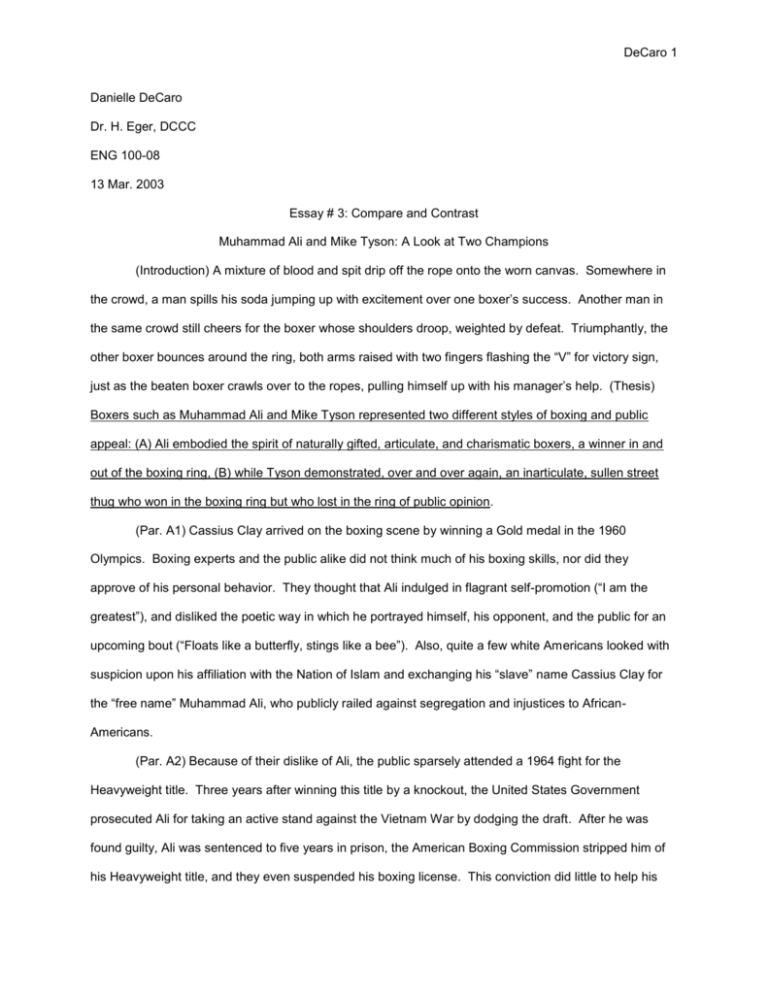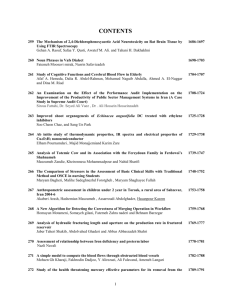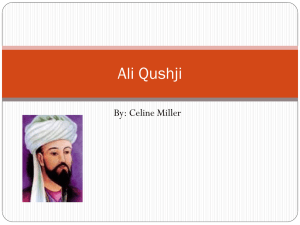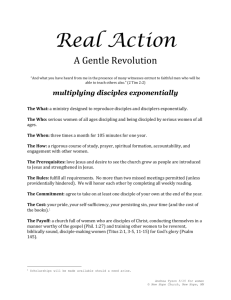Compare & Contrast Essay Sample: DeCaro on 2 boxers
advertisement

DeCaro 1 Danielle DeCaro Dr. H. Eger, DCCC ENG 100-08 13 Mar. 2003 Essay # 3: Compare and Contrast Muhammad Ali and Mike Tyson: A Look at Two Champions (Introduction) A mixture of blood and spit drip off the rope onto the worn canvas. Somewhere in the crowd, a man spills his soda jumping up with excitement over one boxer’s success. Another man in the same crowd still cheers for the boxer whose shoulders droop, weighted by defeat. Triumphantly, the other boxer bounces around the ring, both arms raised with two fingers flashing the “V” for victory sign, just as the beaten boxer crawls over to the ropes, pulling himself up with his manager’s help. (Thesis) Boxers such as Muhammad Ali and Mike Tyson represented two different styles of boxing and public appeal: (A) Ali embodied the spirit of naturally gifted, articulate, and charismatic boxers, a winner in and out of the boxing ring, (B) while Tyson demonstrated, over and over again, an inarticulate, sullen street thug who won in the boxing ring but who lost in the ring of public opinion. (Par. A1) Cassius Clay arrived on the boxing scene by winning a Gold medal in the 1960 Olympics. Boxing experts and the public alike did not think much of his boxing skills, nor did they approve of his personal behavior. They thought that Ali indulged in flagrant self-promotion (“I am the greatest”), and disliked the poetic way in which he portrayed himself, his opponent, and the public for an upcoming bout (“Floats like a butterfly, stings like a bee”). Also, quite a few white Americans looked with suspicion upon his affiliation with the Nation of Islam and exchanging his “slave” name Cassius Clay for the “free name” Muhammad Ali, who publicly railed against segregation and injustices to AfricanAmericans. (Par. A2) Because of their dislike of Ali, the public sparsely attended a 1964 fight for the Heavyweight title. Three years after winning this title by a knockout, the United States Government prosecuted Ali for taking an active stand against the Vietnam War by dodging the draft. After he was found guilty, Ali was sentenced to five years in prison, the American Boxing Commission stripped him of his Heavyweight title, and they even suspended his boxing license. This conviction did little to help his DeCaro 2 public appeal. However, in 1971, the United States Supreme Court found that the Government had acted improperly, and ordered the Boxing Commission to reinstate Ali’s boxing license. The champion successfully won his title back in the ring, not through the courts, but through his sportsmanship. (Par. A3) Publicly, he always appeared as an engaging personality. With his ability to speak in a rhyming fashion, he truly became the first rapper. Perhaps more importantly, Ali developed a method of psychologically demoralizing his opponents before a fight. For example, he would verbally “wear down” his opponents in public with questions and comments about their ability to beat him, all the while verbally “upping” his own belief that he could beat anyone. Because of these unusual tactics, Ali managed to draw great interest in boxing, both here and abroad; people came to like and even admire his style of “dancing” around the ring. Records show that Ali used his Heavyweight Champion title not only for his sport, but also as a platform to speak out against injustices and the need for change in a racially divided 1960’s America, so much so that America’s black youth saw Ali as a role model. Over the course of time, he became an articulate and captivating speaker on racial inequality and on opposition to the Vietnam War. (Par. B1) Quite a different picture appears when looking at Tyson, who in 1984, believed the politics of amateur boxing had cheated him out of Olympic Gold. Some say this period marks the time when the Tyson the public knows today began to emerge and take shape. His managers marketed Tyson as a “ticking time bomb” and Tyson appeared in public enforcing that idea, often with great, unwarranted brutality. Early in his career, he showed a desire not only to knock out his opponents, but to destroy them. When Tyson captured the Heavyweight Champion title in 1986, he had already built a reputation as a brooding and angry street fighter, in and out of the ring. Consequently, the American public saw Tyson as the “angry black youth” of the 1980’s. (Par. B2) In contrast to Ali, Tyson rarely spoke in public due to a severe lisp and a dislike for his own high-pitched voice. Speaking in public seemed to present Tyson with an opponent he could not beat, while Ali intimidated his opponents through his verbal dancing, which helped in his victories. If and when Tyson granted an interview, he subjected the interviewer to mood swings, anger and, on occasion, even bodily threats, without showing any of Ali’s charisma and political convictions (“Sometimes you guys have no pride, so no matter what I say, you guys . . . it doesn't affect you . . . So every now and then I kick DeCaro 3 your [expletive] ass and stomp on you”). However, Tyson still managed to draw crowds to the sport of boxing, largely due to people’s amazement at his capacity for violence and anger. (Par. B3) Nonetheless, the very traits that had made Tyson a great fighter––violence, rage, and a lack of restraint––eventually led to his downfall. He was arrested and jailed, not for political or religious beliefs like Ali, but for the crimes of rape and assault. Those crimes, and Tyson’s failure to acknowledge any guilt, did nothing to improve his public appeal, and brought disgrace to the sport of boxing. Once out of prison, rather than winning his title back as Ali did, Tyson filed lawsuit after lawsuit to have his title and license reinstated, while using the media to announce his conversion to Islam. Instead of using the opportunity afforded by his reinstated boxing license to promote his religious beliefs or show the lighter side of himself, Tyson once again plunged the public’s idea of boxing into disarray by biting off Evander Holyfield’s ear, something that a true sportsman like Ali has never done. By displaying his new ferociousness in the ring, Tyson had brought the sport of boxing full circle to its origins as a “blood sport.” (Summary) Both Ali and Tyson raised boxing to a high-interest point during their careers. Both boxers possessed the ability to draw a crowd and spark new interest in the sport of boxing––Ali through his style and wit, Tyson through his rage and violence. While Ali gained great appeal as a boxer and as a human being with his wit and charm, Tyson never really demonstrated either quality. Ali brought style and grace to the world of boxing where Tyson made the sport of boxing synonymous with unrestrained violence and anger. (Conclusion) Students of boxing will pour over the Tyson fights and the Ali fights, which rank among the greatest in modern boxing history. They will study Ali’s shenanigans, the beauty and grace he brought to the ring, and the ability he mastered for creating fear in his opponents by simply talking. These same observers will also witness Tyson’s rage, his disdain for the rules of the sport, women, and the press, and the fear he created in his opponents due to the anger he kept bubbling below the surface. Ultimately, because of Tyson’s failures and crimes, he could not reach the public stature of Ali as a positive role model in the sports community. Though boxing does not rank as my favorite sport, I keep my fingers crossed in the hopes that Ali’s fairness and personality will make a stronger impression on young people watching sports documentaries than Tyson’s angry outbursts. Word Count: 1270






